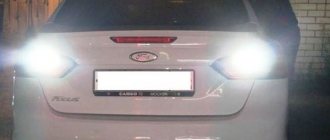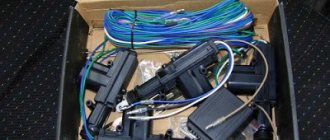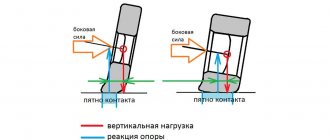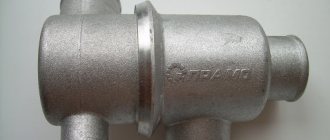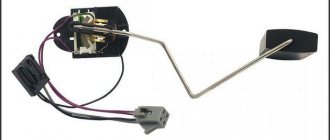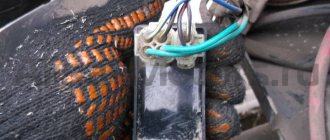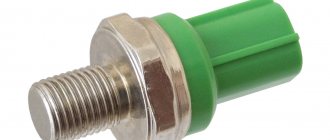When operating vehicles, there is a need to obtain various information. The list of types of sensors can take up an entire page. Most of them are not self-sufficient: a set of information is used to control the operation of the machine. The exception is the most popular device that produces data - the speedometer sensor. It measures two important parameters: current speed and mileage. To determine the service life of a running engine, wear is measured not in engine hours, but by the mileage of the vehicle.
So, the main tasks of the speed measurement sensor are:
- Actually measuring the speed of movement. The driver sees the parameter on the speedometer, adheres to the traffic rules and ensures normal operating conditions of the engine and gearbox. Even if you do not strictly follow road limit signs, you can choose a safe speed depending on the driving conditions. In addition, the DKS provides information to electronic modules that provide active safety: ABS, ESP, rollover prevention systems and hill descent assistance. The speedometer drive sensor operates in real time (displayed on the dashboard) and stores readings in the presence of an advanced electronic control system.
- Mileage recording. The parameter is responsible for maintaining service intervals and providing an economizer: a fuel consumption meter. The speedometer drive sensor provides mileage information directly to the instrument panel and stores it in electronic modules. Thanks to this data, you can find out the real condition of the car when buying second hand.
What does the speed sensor affect? In a modern car, it is involved in the operation of several systems:
- on a moving vehicle, the specified idle speed is also regulated;
- fuel cut-off when the throttle valve is closed: signals are supplied by the crankshaft speed sensor and the vehicle speed sensor;
- The automatic transmission control unit synchronizes the speed of the input and output shafts, receiving data on speed and load.
Design and principle of operation
The DS device is based on the Hall effect; the device transmits pulse-frequency signals to the ECU at certain intervals.
So, over one kilometer of travel, this device transmits about 6,000 signals and, based on the data received, the control unit automatically calculates the speed of the vehicle. The higher the speed of the car, the more intense the pulses arrive at the controller. In addition to determining speed, this device performs another important function. When the car is coasting, the pulse sensor does not block the flow of fuel, thereby contributing to savings. The principle of operation of the DS is quite simple, but if any malfunctions occur, this affects the operation of the power unit. Today it is customary to distinguish several types of DSAs, differing in design: inductive, reed and based on the Hall effect (electronic sensors).
Speed sensor: operating features, malfunctions and replacement
A speed sensor is one of many automotive sensors responsible for generating measurement information signals, transmitting it, further converting and processing it by an electronic control unit and some other devices. If the car does not have an ECU, the need for sensors does not become less.
The output of even the least important of the sensors affects at least how comfortable it will be to operate the car.
Since the speed sensor is quite important, let's try to understand the features of its device, analyze the main faults and try to understand how, if necessary, even an inexperienced car enthusiast can replace it.
Main causes of malfunction
A speed sensor breakdown should be repaired in a timely manner before it develops into an expensive repair. To do this, every car owner must monitor how his vehicle behaves while driving. At the slightest deviation from the established norm, it is recommended to replace the DSA. The main symptoms of a speed sensor malfunction:
- fuel consumption increases;
- incorrect speedometer readings;
- the engine is unstable at idle;
- the motor does not develop full power.
Also, signs of speed sensor failure may appear in situations where the engine stops working at idle, while squeezing the clutch, or while shifting gears. In this case, the driver will see an indicator with the words “Check engine”; if there is a computer, the display will show error “24”. In this situation, the first step is to check the condition of the contacts and wires; perhaps an open circuit will be detected. As a rule, this occurs near the connector where there is a bend, and the wires can fray. If the contacts are simply dirty or oxidized, they need to be cleaned. You also need to monitor the integrity of the wire insulation at the exhaust manifold. A sensor malfunction may be caused by a failure of the speedometer cable, which has become worn out during operation.
In modern cars, an electronic control unit and various sensors, including the Toyota speed sensor, are responsible for the injection of the combustible mixture at different engine operating modes. The ECU, analyzing the condition of the car based on many factors, promptly carries out calculations, accurately doses the amount of combustible mixture and determines the time for which the injector of a certain engine cylinder opens at the required moment in time.
The controller must receive information from the vehicle sensors:
- about the speed of movement;
- about the throttle position;
- about the position of the engine crankshaft;
- air and coolant temperature;
- about the presence of detonation and other data.
Purpose
The speed sensor is designed to inform the electronic control unit about the speed of the vehicle. In addition, it is also assigned an information function - speedometer readings on the control panel.
Engine operating modes, which are associated with cutting off the fuel supply in the event of closing the throttle valve when the car is in motion, as well as the smooth transition of the engine to idle mode, depend on engine speed and speed. The control unit, having received the necessary impulses, adjusts or changes the parameters of the engine operating modes. Therefore, when the car is moving at high speed, the idle speed is maintained slightly higher than when driving at low speed or when the car is stationary.
Principle of operation
Speed sensor circuit
Operating principle of the speed sensor
Many car enthusiasts do not know where the speed sensor is located and especially how it works. The Toyota speed sensor is mounted on the gearbox housing.
The operating principle is quite simple and is based on the Hall effect. While the vehicle is moving, voltage pulses are transmitted from the sensor to the electronic control unit, the frequency of which is directly proportional to the speed of rotation of the vehicle's drive wheels. The task of the device is to generate a certain number of frequency pulses per revolution of the car wheel. These pulses are a kind of frequency signal to the controller to carry out the necessary calculations. When designing each car, it is designed for wheels of certain sizes. Therefore, if you install wheels of a different size than those provided by the manufacturer on your car, the speed readings of the car may change slightly.
The speed sensor generates approximately 6004 pulses for each kilometer traveled. The controller determines the speed of the vehicle based on the time intervals between pulses. After calculation, data on driving speed is also displayed on the speedometer in a form convenient for the driver.
Consequences of device failure
The car's electronic system regularly diagnoses all sensors installed on the car, including the speed sensor. The diagnostic system determines the malfunction of any sensor by the absence of a signal from it.
If there is no signal from a faulty motion sensor, the vehicle's electronic control unit cannot determine the state of the vehicle: whether it is moving or standing still. And only when the engine starts to operate at high speeds under increased load and the air consumption increases accordingly, the system determines that the car is in motion. If, under such conditions, there are still no signals (impulses) from the device, then the electronic control unit generates a CHECK ENGINE error.
A malfunction of the speed sensor primarily affects the maintenance and regulation of idle speed while the vehicle is moving. So, if you suddenly release the accelerator pedal or turn off the gearbox (sharp decrease in engine load), the engine may stall. When you press the accelerator sharply, for example for dynamic acceleration, you will notice a significant loss of the engine's dynamic characteristics during acceleration. The engine will stop (stall) when the vehicle is coasting or when changing gears.
Location of the speed sensor on the automatic transmission
Close-up location of the speed sensor on the automatic transmission
You can check the device in 3 ways, for the first two you need a multimeter.
FIRST METHOD
- the sensor is removed;
- using a multimeter you need to find out what each contact is responsible for, you need to find the pulse one;
- the positive probe is connected to the pulse contact, and the negative probe is connected to the car body or engine;
- A piece of tube is put on the sensor axis and rotates at a low speed, while the voltage is measured with a multimeter: the higher the rotation speed, the higher the pulse frequency and voltage.
SECOND METHOD (WITHOUT DISASSEMBLY)
- use a jack to lift one of the front wheels of the car;
- the multimeter is connected to the sensor wires;
- you need to rotate the wheel and check whether pulses appear (if so, the device is working normally).
THIRD METHOD (WITHOUT MULTIMETER)
If a measuring device is not available, the test can be performed using a test lamp or a regular 12-volt light bulb. The procedure is similar to the second method.
- The pulse wire is disconnected from the sensor;
- with the ignition on, use a control lamp to find “plus” and “minus”;
- the wheel is hung out;
- the control lamp is connected to the signal wire, the wheel rotates (if the “minus” lights up on the control, the sensor is working).
If you don’t have a warning lamp at hand, you can use a 12-volt one (for example, from a turn signal). The wire connects the battery plus and the signal contact. If the sensor is operational, the light will blink.
If the check shows that the device is working properly, you need to check how its drive works. To do this, the front wheel is hung out. You need to find the sensor drive by touch. Then you need to rotate the wheel with your foot, and with your hand you need to check whether there is rotation in the drive and whether it is stable.
Replacing sensors
The cause of failure of speed sensors is a short circuit in the wiring when the wires come into contact with the exhaust manifold, which begin to melt due to high temperature.
Original sensor
Andrey Goncharov, expert in the “Car Repair” section
Self-test
Every car owner should know how to check the speed sensor . There are three possible ways to determine if it is working properly. Before starting diagnostics, you should determine whether the sensor produces 12 V, since the basic principle of operation of the internal combustion engine is based on the Hall effect, the state of the contacts occurs exclusively during rotation. The voltage readings of the sensor in operating condition should be within 0.5-10 V. 1. Check with a voltmeter. The DSA needs to be removed and it will be determined what each terminal is responsible for. One contact of the voltmeter should be connected to the terminal that outputs pulse signals, and the second should be connected to the ground wire. The sensor must be rotated and at this time look at the voltage readings. The more intense the sensor rotates, the higher the readings will be. 2. It is necessary to disconnect the impulse wire, which is detected by a special controller, and lift the wheel to rotate with a jack so that it does not touch the ground. Connect the “Signal” control wire; if the indicator is “-“, then the speed sensor is working. A wire with a light bulb can replace the control in this method. 3. To determine the operation of the sensor, it is not necessary to remove it from the machine; to do this, you can lift it, as in the previous method. Next, connect the voltmeter to the sensor contacts; the device will display voltage readings when the wheel rotates. If the voltmeter shows voltage and frequency in Hz, this indicates that the DS is working.
Gazelle speed sensor does not work - April 6, 2011
To get to the speed sensor on the Gazelle, you need to unscrew all the screws securing the hatch around the gear shift knob:
We pull out and disconnect the sensor chip. Checking the functionality of the DSA should begin with the presence of grounding on pin “3” and supply voltage (+12V) on pin “1”. The black wire is negative and the yellow wire is positive, the green wire goes to the controller and to the instrument panel, as can be seen from the diagram:
Where number 66 is our speed sensor. We also see that the positive going to our sensor comes to the reverse switch, so if the reverse lights light up when you turn on reverse gear and the ignition, then you don’t have to check the fuse.
But here is the electrical circuit, after assembling it, you can check the speed sensor itself:
Or connect another (known good) sensor to the connector, turn on the ignition and turn the sensor shaft and look at the speedometer needle, it jerks - that means everything is fine, the sensor should be replaced.
In my case there was no negative on the black wire. I cleaned it up and wound up additional mass:
I soldered the twist and insulated it well:
I passed the wire under the rubber mat and screwed it between the seats to ground:
How to replace the speed sensor
Replacing the speed sensor is a fairly simple procedure that does not take much time, so many drivers do it themselves. To replace the speed sensor yourself, you must follow the procedure algorithm: The battery must be disconnected from the on-board grid and only after that the DS must be disconnected. In this case, it is recommended to use two keys in work - “10” and “21”. In some cases, you will need keys of a different size, depending on the make of the car. It is necessary to unscrew the sensor itself as carefully as possible (so as not to damage the rod). If it cannot be repaired, you need to purchase an identical one with an equal number of teeth on the gear. Installing a new element occurs in the reverse order. The rod is installed in the sensor sleeve, followed by an O-ring pre-treated with oil, and the speed sensor is fixed in place. After installing the new device, the ECU errors should be reset, otherwise the machine will not consider the sensor replacement effective.
Other types of speed sensors: reed switch type and induction type sensor
Although such sensors are used much less frequently than Hall effect sensors, such solutions are found on some cars. For this reason, it is necessary to take into account some features.
- A sensor with a reed switch produces signals in the form of rectangular pulses with a cycle of 40-60%, while switching is carried out from 0 to 5V or from 0 to battery voltage 12V.
- As for the induction sensor, the signal from the rotation of the wheels is similar to a wave oscillation (wave impulse). As a result, the voltage changes based on the rotation speed. The principle itself is similar to the operation of the crankshaft angle sensor.
What to pay attention to
Before starting the procedure for replacing the speed sensor, you need to turn off the ignition, since the presence of voltage in the circuit when connecting a voltmeter can lead to a short circuit and failure of other elements. In order to avoid encountering rod defects when removing the speed sensor, it is necessary to dismantle the speedometer drive. To remove it, use a regular wrench. The procedure should be carried out very carefully, removing the drive from the body of the gearbox, and it is important not to lose the rod in the place of the manual transmission.
Let's sum it up
The speed sensor (speedometer sensor) is an important element in the electronic engine control system. If the driver notices the signs of engine malfunctions discussed in the article, special attention should be paid to the vehicle speed sensor.
We also recommend reading the article about what a phase sensor is. From this article you will learn about the signs of a faulty phase sensor, as well as how to check it.
In addition to checking other sensors (mass air flow sensor, speed sensor, speed sensor, etc.), it is also necessary to diagnose the speed sensor. The reason is that the failure of one or another sensor will not always be accompanied by the lighting of the “check engine” warning light on the instrument panel. As a result, in-depth diagnostics are required.
How to extend the service life of a DS
The design of the DS is not particularly complicated, and almost every car owner can replace it independently. Therefore, many do not pay due attention to this device, which to some extent contributes to its malfunction. Drivers who drive at high speeds are at greater risk, since the installed speed sensor has a plastic shank, which is quickly broken by a cable during strong vibration.
Often the cause of the malfunction can be the cable itself, since it is influenced by factors such as moisture and reagents used to treat roads. This destroys its structure: the cable loses its original elasticity, begins to crack and delaminate. To prevent it from premature rubbing, you need to regularly treat it with any machine oil, pumping it with a syringe under the braid.
Special attention should be paid to the DS shank in the place where the sensor itself and the cable are connected. If the shank is plastic, it becomes loose during the operation of the car, which leads to the fact that its seat becomes broken. This leads to the fact that the DS fails, and the shank cannot be repaired. As a result, you will have to change the entire device. You should also know that the speed sensor contacts need regular cleaning, since exposure to external factors leads to their oxidation. Deterioration of voltage conductivity can lead to a short circuit that will damage the device. Now every car owner can evaluate the value of the speed sensor in the vehicle, which, in addition to determining the speed, also affects the operation of the power unit. Therefore, it is important to promptly detect and eliminate the malfunction, and, if necessary, resort to replacing it. Before installing a part, the above testing methods must be used to determine its functionality.
How to fix the problem
Once it has been possible to determine the malfunction of the speed sensor, further actions depend on the reasons that caused this situation. The following solutions are possible:
- Dismantling the sensor and checking it using a multimeter using the above method. If the sensor is faulty, it is most often replaced with a new one, since it is quite difficult to repair it. Some “traditional craftsmen” try to solder flying chip elements manually using a soldering iron. However, this does not always work out, so it is up to the car owner to decide whether to do this or not.
- Check sensor contacts. One of the most popular reasons why the speed sensor does not work is contamination and/or oxidation of its contacts. In this case, it is necessary to inspect them, clean them, and also lubricate them with special lubricants in order to prevent the occurrence of corrosion in the future.
- Check the integrity of the sensor circuit. Simply put, “ring” the corresponding wires using a multimeter. There can be two problems - a short circuit and a complete break in the wires. In the first case, this is caused by damage to the insulation. A short circuit can occur either between individual pairs of wires or between one wire and ground. You need to go through all the options in pairs. If the wire breaks, there will be no contact at all. If there is slight damage to the insulation, it is permissible to use heat-resistant insulating tape to repair the damage. However, it is still better to replace the damaged wire (or the entire harness), since the wires often operate at high temperatures, so there is a high risk of repeated damage. If the wire breaks completely, then, naturally, it needs to be replaced with a new one (or the entire harness).
Sensor repair
Some auto repairmen with electronics repair skills are engaged in restoring the speed sensor on their own. In particular, in the case described above, when under the influence of high temperature the capacitor is soldered off and it begins to short-circuit and pass current.
This procedure consists of disassembling the speed sensor housing to check the functionality of the capacitor and, if necessary, replacing it. As a rule, microcircuits contain Japanese or Chinese capacitors, which can easily be replaced with domestic ones. The main thing is to choose the appropriate parameters - the location of the contacts, as well as its capacity. If the sensor housing is dismountable, everything is simple, you just need to remove the cover in order to get to the capacitor. If the case is non-separable, you need to carefully cut it without damaging the internal components. In addition to the requirements listed above for choosing a capacitor, you also need to pay attention to its size, since after soldering to the board, the sensor housing should be closed again without any problems. You can glue the case using heat-resistant glue.
According to reviews from craftsmen who have performed a similar operation, you can save several thousand rubles in this way, since a new sensor is quite expensive.
Conclusion
A breakdown of the speed sensor is a non-critical, but quite unpleasant problem. After all, not only the speedometer and odometer readings depend on its normal operation, but also fuel consumption increases, and the engine does not operate at full power. In addition, individual vehicle systems are forcibly switched off, which can, among other things, affect traffic safety, both in city mode and on the highway. Therefore, when identifying problems with the speed sensor, it is advisable not to delay fixing them.
Maybe
